If your off-roading plans include driving on a beach then, at some stage, you will get bogged. No matter how great a driver you are or, more to the point, you think you are, you will get bogged – everyone does.
The sooner you get comfortable with that idea the better, because that way you’ll be able to formulate a plan to get yourself or others out of strife. Better still, follow our advice, sort out your own strategy to suit, and you’ll be recovery-ready all the time.
DON’T RUSH
_0.jpg)
Relax – getting bogged and getting out are all part of the fun. There is no screaming urgency to extract your vehicle from its boggy predicament, unless you’re stuck below the high-tide mark on a beach and the tide’s rapidly coming in. A rushed vehicle-recovery is a risky one – to you, bystanders and the vehicle.
Now is the time to assess the situation: How bad is it? Are all four wheels bogged? Is the underbody snagged on a half-buried tree stump, branch or rock? Clear away all obstacles from under and around the stuck vehicle and formulate a plan of action.
AIR DOWN YOUR TYRES
A lot of people get bogged, especially on beaches, because they haven’t bothered dropping their tyre pressures. You’re obviously clever, because you’re reading this yarn, so you would have already aired down your tyres to between 15 and 18 psi (pounds per square inch).
When bogged on sand, chances are you’ll be able to get out of strife by simply digging away a bit of sand and dropping tyre pressures further.
So, the process at this point goes like this: drop pressures, then drive; drop, then drive – until you’re out.
GET OUT YOUR VEHICLE-RECOVERY TRACKS
.jpg)
If dropping tyre pressures doesn’t work, it’s time to get your vehicle-recovery tracks* ready. (*These resemble hard plastic snowboards with rows of hard moulded lumps along one surface of the board and are generally sold in pairs. We’re using MaxTrax in the accompanying photos, but there other brands including ARB Tred Pro etc.)
If you have a good-quality set of vehicle-recovery tracks, you will be able to use them inverted as shovels to dig sand out from in front of each tyre and as much as you can from underneath the vehicle, if needed. Use a long-handled shovel as well because vehicle-recovery tracks are no substitutes for shovels.
.jpg)
Once you’ve cleared the sand away, flip each track over so its ramp-side is up and wedge each one under the wheels, at an angle not flat, facing in the direction you want to travel; so, in front of both front and rear tyres if you’re going forward and behind both front and rear tyres if you’re reversing.
At this point, it will help to drop tyre pressures even further – if they’re not too low already – as this will provide even more traction.
GO SLOW
.jpg)
When you’re about to undertake a vehicle-recovery, move all bystanders well out of the way.
Make sure your vehicle is in 4WD Low (or the equivalent in your vehicle) and slowly accelerate. By going inchworm slowly, it allows your tyres to grip the tracks, creep up them and then out. If your wheels start spinning, stop immediately, get out, reposition the tracks, wedge them into place, and try again.
.jpg)
All going well, your vehicle will slowly drive up and along each track until it reaches the end of them and hits the soft sand again. You may only need to do this whole procedure once to get out of a boggy patch or you may need to do it a few times.
If things go from bad to worse, and you're unable to get out using MaxTrax, you'll need a recovery kit, which usually includes rated bow shackles, gloves, a snatch strap – to be used only on vehicles with rated recovery points – and more. Get a top-quality kit (ARB RK9 recovery kit RRP $480 or Ironman 4x4 recovery kit, RRP $345).
Read this yarn to find out how to use a snatch strap to get your vehicle out of a bogged situation.
CLEAN UP AFTER YOURSELF
As you should do after any beach drive, make sure you thoroughly wash your vehicle. That way, you’ll keep all surfaces and mechanicals clear of sand, grit and salt spray which can damage bodywork, wiring and other components.
THE GEAR YOU NEED
If you haven’t already realised, part of being prepared for any off-roading adventure is having the skills and having the gear.
There is a mind-boggling variety of vehicle-recovery gear available, ranging in quality and price and for all manner of trips – from cruisy weekend bush sojourns to three-month-long remote-area expeditions. Stick to the basics for starters and make sure you have good-quality equipment onboard.
Get:
A tyre-pressure gauge
A tyre deflator
Vehicle-recovery tracks
An air compressor
A long-handled shovel
Rated bow shackles
Snatch strap
What's your best tip for getting unbogged? Tell us in the comments below.




.jpg)
.jpg)


.jpg)


Comments